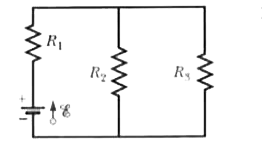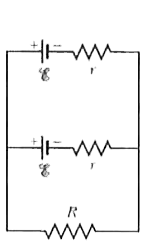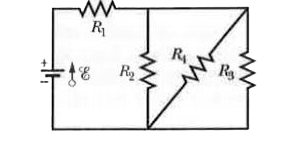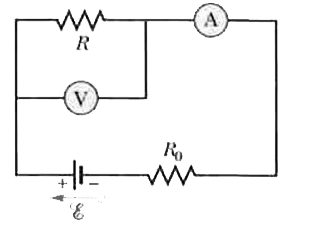In Fig. 27-42, the resistances are R1=3.00Ω,R2=700Ω. and the battery is ideal. What value of R3 maximizes the dissipation rate in resistance 3? 
The correct Answer is:2.10Ω
Topper's Solved these Questions
- CIRCUITSBOOK - RESNICK AND HALLIDAYCHAPTER - CIRCUITSEXERCISE - Practice Questions (Single Correct Choice Type)
33 Videos
- CIRCUITSBOOK - RESNICK AND HALLIDAYCHAPTER - CIRCUITSEXERCISE - Practice Questions (More than One Correct Choice Type)
12 Videos
- CIRCUITSBOOK - RESNICK AND HALLIDAYCHAPTER - CIRCUITSEXERCISE - Checkpoints
7 Videos
- CENTER OF MASS BOOK - RESNICK AND HALLIDAYCHAPTER - CENTER OF MASS EXERCISE - Practice Questions (Integer )
4 Videos
- CIRCULAR MOTIONBOOK - RESNICK AND HALLIDAYCHAPTER - CIRCULAR MOTIONEXERCISE - CHECK POINTS
6 Videos
Similar Questions
In Fig. 27-40, the resistors have the values R1=700Ω,R2=12.0Ω,andR3=4.00Ω and the ideal battery's emf is 22.0 V. For what value of R4 Will the rate at which the battery transfers energy to the resistors equal (a) 60.0 W, (b) the maximum possible rate Pmaxand and (c) the minimum possible rate Pmin? What are (d) Pmaxand(e)Pmin?
View SolutionIn Fig. 27-38, two batteries with an emf ε=12.0V and an internal resistance r=0.500 Ω are connected in parallel across a resistance R. (a) For what value of R is the dissipation rate in the resistor a maximum? (b) What is that maximum? and (c) what is the total dissipation rate in the batteries? In terms of r, what are (d) the effective R (internal) resistance of the two-battery system and (e) the resistance R that is required to maximize the dissipation rate? This is a general result.

View Solution
Knowledge Check
Two resistors of resistances R1=(300±3)Ω and R2=(500±4)Ω are connected in series. The equivalent resistance of the series combination is
A(800±1)ΩB(800±7)ΩC(200±7)ΩD(200±1)Ω
In Fig. 27-40, R1=100Ω,R2=R3=50.00Ω,R4=75.0Ω, and the ideal battery has emf ε=12.0V. (a) What is the equivalent resistance? What is i in (b) resistance 1, (c) resistance 2,(d) resistance 3, and (e) resistance 4?

View SolutionIn Fig 27.37, ε1=1.00V,ε2=3.00V,R1=4.00Ω,R2=2.00Ω,R3=5.00Ω, both batteries are deal. What is the latest which energy is dissipated in (a) R1,(b)R2and(c)R3? What is the power of (d) battery 1 and (e) ballery 2? Is energy being absorbed or provided in (f) battery and (g) battery 2?
View SolutionTwo resistance R1=100±3ΩandR2=200±4Ω are connected in seriesg. What is their equivalent resistance?
View SolutionIn Fig. 27-43, the current in resistance 6 is i6=2.80A the resistances are R1=R2=R3=2.00Ω,R4=16.0Ω,R5=8.00ΩandR6=4.00Ω. Wat is the emf of the ideal battery?

View SolutionIn Fig. 27-39, a voltmeter of resistance Rv=300Ω and ammeter of resistance RA=3.00Ω are being used to measure a resistance R in a circuit that also contains a resistance R0=100Ω and an ideal battery with an emf of ε=18.0V. Resistance R is given by R =V/i, where V is the potential across R and i is the ammeter reading. The voltmeter reading is V', which is V plus the potential dilference across the ammeter. Thus, the ratio of the two meter readings is not R but only an apparent resistance R' -V/i. If R =85.0Ω what are (a) the ammeter reading.

(b) the voltmeter reading, and (c) R'? (a) If RA is decreased, does the difference between R' and R increase, decrease, or remain the same?
View SolutionIn Fig 27-53, a voltmeter of resistance Rv=300Ω and an ammeter of resistance RA=3.00Ω are being used to measure a resistance R in. a circuit that also contains a resistance R0=100Ω and an ideal battery of emf ε=28.5V. Resistance R is given by R=V//i where V is the voltmeter reading and i is the current in resistance R. However, the ammeter reading is not i but rather i', which is i plus the current through the voltmeter. Thus, the ratio of the two meter readings is not R but only an apparent resistance R'=V/I'. If R=85.0Ω what are (a) the ammeter reading. (b) the voltmeter reading, and (c) R' (d) If Rv is increased does the difference between R' and R increase, decrease or on the same?

View SolutionIn Fig. 27-45, assume that ε=3.0V,r=100Ω,R1=25022andR2=300Ω. If the voltmeter resistance RV is 5.0kΩ. what percent error does it introduce into the measurement of the potential difference across R1?. Ignore the presence of the ammeter.

View Solution
